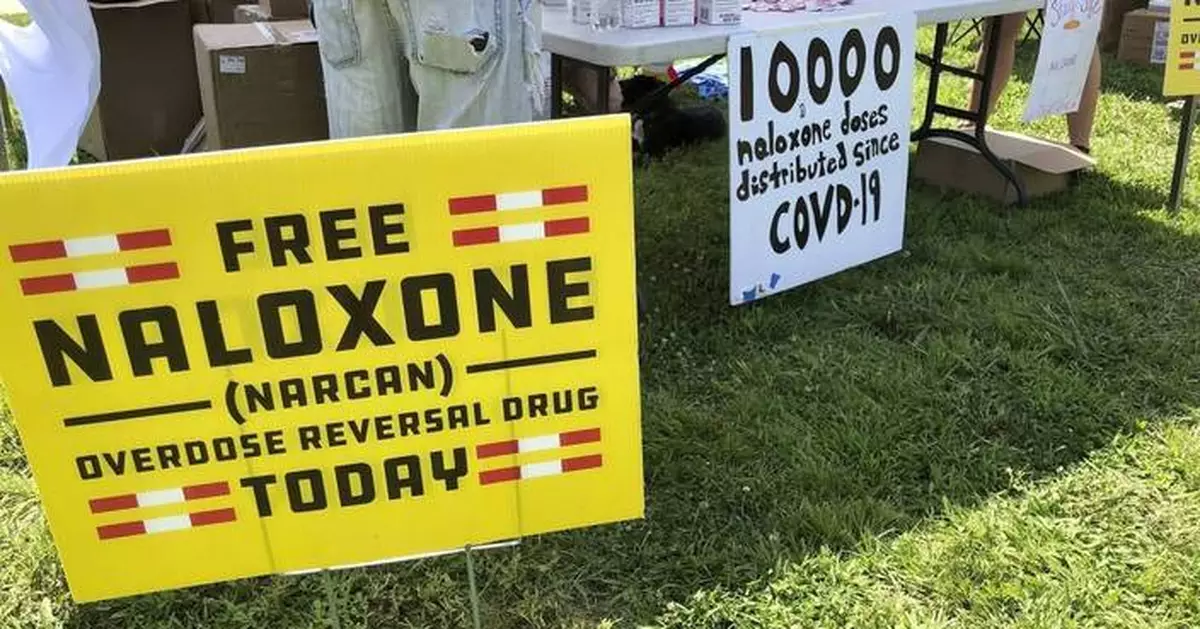CHARLESTON, W.Va. (AP) — West Virginia's Supreme Court on Monday declined to answer a federal court's question in an appeal in a landmark lawsuit over whether the distribution of opioids can cause a public nuisance.
The 3-2 opinion returns the case to the 4th U.S. Circuit Court of Appeals in Richmond, Virginia.
It's been nearly three years since a federal judge in Charleston ruled in favor of three major U.S. drug distributors who were accused by Cabell County and the city of Huntington of causing a public health crisis by distributing 81 million pills over eight years in the county. AmerisourceBergen Drug Co., Cardinal Health Inc. and McKesson Corp. also were accused of ignoring the signs that Cabell County was being ravaged by addiction.
U.S. District Judge David Faber in Charleston said West Virginia’s Supreme Court had only applied public nuisance law in the context of conduct that interferes with public property or resources. He said to extend the law to cover the marketing and sale of opioids “is inconsistent with the history and traditional notions of nuisance.”
Last year the appeals court in Richmond, Virginia, sent a certified question to the state Supreme Court, which states: “Under West Virginia’s common law, can conditions caused by the distribution of a controlled substance constitute a public nuisance and, if so, what are the elements of such a public nuisance claim?”
Had the state justices ruled that opioids distribution can cause a public nuisance, the case would have returned to the 4th Circuit anyway. Had the West Virginia court found that opioids can’t cause a public nuisance, the appeal would have ended, the 4th Circuit has said.
Instead, a majority of the West Virginia justices refused to get involved.
Justice Haley Bunn delivered the opinion of the West Virginia Supreme Court. Justice Beth Walker, who is retiring next month, issued a separate opinion. Chief Justice Bill Wooton was joined in a dissenting opinion by Circuit Judge Tera Salango. Salango and Circuit Judge Andrew Dimlich heard the case on temporary assignment after two other justices disqualified themselves.
Paul Farrell Jr., an attorney representing the plaintiffs, said Monday he was disappointed that the justices declined to answer the legal question.
“The fight isn’t over," Farrell said. "There’s still a long way to go. We continue on our path to seek justice.”
Farrell said the appeals court still must address a combination of factual and legal issues.
A Cardinal Health spokesperson declined to comment on Monday’s ruling. Emails seeking comment from AmerisourceBergen and McKesson weren’t immediately returned.
During arguments earlier this year before the state Supreme Court over the certified question, Steve Ruby, an attorney for the companies, called the plaintiffs’ arguments to grant the public nuisance “radical” and that, if granted, it would “create an avalanche of activist litigation.”
Thousands of state and local governments have sued over the toll of opioids. The suits relied heavily on claims that the companies created a public nuisance by failing to monitor where the powerful prescriptions were ending up. Most of the lawsuits were settled as part of a series of nationwide deals that could be worth more than $50 billion. But there wasn’t a decisive trend in the outcomes of those that have gone to trial.
The appeals court had noted that the West Virginia Mass Litigation Panel, which works to resolve complex cases in state court, has concluded in several instances that opioid distribution “can form the basis of a public nuisance claim under West Virginia common law.”
In his 2022 decision, Faber also said the plaintiffs offered no evidence that the defendants distributed controlled substances to any entity that didn’t hold a proper registration from the U.S. Drug Enforcement Administration or the state Board of Pharmacy. The defendants also had suspicious monitoring systems in place as required by the Controlled Substances Act, he said.
In 2021 in Cabell County, an Ohio River county of 93,000 residents, there were 1,059 emergency responses to suspected overdoses — significantly higher than each of the previous three years — with at least 162 deaths.
The plaintiffs had sought more than $2.5 billion that would have gone toward opioid use prevention, treatment and education over 15 years.

FILE - Signs are displayed at a tent during a health event on June 26, 2021, in Charleston, W.Va. (AP Photo/John Raby, File)
LAS VEGAS (AP) — With the start of the New Year squarely behind us, it's once again time for the annual CES trade show to shine a spotlight on the latest tech companies plan on offering in 2026.
The multi-day event, organized by the Consumer Technology Association, kicks off this week in Las Vegas, where advances across industries like robotics, healthcare, vehicles, wearables, gaming and more are set to be on display.
Artificial intelligence will be anchored in nearly everything, again, as the tech industry explores offerings consumers will want to buy. AI industry heavyweight Jensen Huang will be taking the stage to showcase Nvidia's latest productivity solutions, and AMD CEO Lisa Su will keynote to “share her vision for delivering future AI solutions.” Expect AI to come up in other keynotes, like from Lenovo's CEO, Yuanqing Yang.
The AI industry is out in full force tackling issues in healthcare, with a particular emphasis on changing individual health habits to treat conditions — such as Beyond Medicine's prescription app focused on a particular jaw disorder — or addressing data shortages in subjects such as breast milk production.
Expect more unveils around domestic robots too. Korean tech giant LG already has announced it will show off a helper bot named “ CLOiD,” which allegedly will handle a range of household tasks. Hyundai also is announcing a major push on robotics and manufacturing advancements. Extended reality, basically a virtual training ground for robots and other physical AI, is also in the buzz around CES.
In 2025, more than 141,000 attendees from over 150 countries, regions, and territories attended the CES. Organizers expect around the same numbers for this year’s show, with more than 3,500 exhibitors across the floor space this week.
The AP spoke with CTA Executive Chair and CEO Gary Shapiro about what to expect for CES 2026. The conversation has been edited for clarity and length.
Well, we have a lot at this year's show.
Obviously, using AI in a way that makes sense for people. We’re seeing a lot in robotics. More robots and humanoid-looking robots than we’ve ever had before.
We also see longevity in health, there’s a lot of focus on that. All sorts of wearable devices for almost every part of the body. Technology is answering healthcare’s gaps very quickly and that’s great for everyone.
Mobility is big with not only self-driving vehicles but also with boats and drones and all sorts of other ways of getting around. That’s very important.
And of course, content creation is always very big.
You are seeing humanoid robots right now. It sometimes works, sometimes doesn’t.
But yes, there are more and more humanoid robots. And when we talk about CES 5, 10, 15, 20 years now, we’re going to see an even larger range of humanoid robots.
Obviously, last year we saw a great interest in them. The number one product of the show was a little robotic dog that seems so life-like and fun, and affectionate for people that need that type of affection.
But of course, the humanoid robots are just one aspect of that industry. There’s a lot of specialization in robot creation, depending on what you want the robot to do. And robots can do many things that humans can’t.
AI is the future of creativity.
Certainly AI itself may be arguably creative, but the human mind is so unique that you definitely get new ideas that way. So I think the future is more of a hybrid approach, where content creators are working with AI to craft variations on a theme or to better monetize what they have to a broader audience.
We’re seeing all sorts of different devices that are implementing AI. But we have a special focus at this show, for the first time, on the disability community. Verizon set this whole stage up where we have all different ways of taking this technology and having it help people with disabilities and older people.
Well, there’s definitely no bubble when it comes to what AI can do. And what AI can do is perform miracles and solve fundamental human problems in food production and clean air and clean water. Obviously in healthcare, it’s gonna be overwhelming.
But this was like the internet itself. There was a lot of talk about a bubble, and there actually was a bubble. The difference is that in late 1990s there were basically were no revenue models. Companies were raising a lot of money with no plans for revenue.
These AI companies have significant revenues today, and companies are investing in it.
What I’m more concerned about, honestly, is not Wall Street and a bubble. Others can be concerned about that. I’m concerned about getting enough energy to process all that AI. And at this show, for the first time, we have a Korean company showing the first ever small-scale nuclear-powered energy creation device. We expect more and more of these people rushing to fill this gap because we need the energy, we need it clean and we need a kind of all-of-the-above solution.

A Coro breastfeeding monitor is pictured at a Coroflo booth during the CES Unveiled tech show Sunday, Jan. 4, 2026, in Las Vegas. (AP Photo/Abbie Parr)

Yonbo X1 robots are pictured at the X-Orgin booth during the CES Unveiled tech show Sunday, Jan. 4, 2026, in Las Vegas. (AP Photo/Abbie Parr)

A Tombot robotic puppy is pictured at a Tombot booth during the CES Unveiled tech show Sunday, Jan. 4, 2026, in Las Vegas. (AP Photo/Abbie Parr)

People arrive at the CES Unveiled tech show Sunday, Jan. 4, 2026, in Las Vegas. (AP Photo/Abbie Parr)














